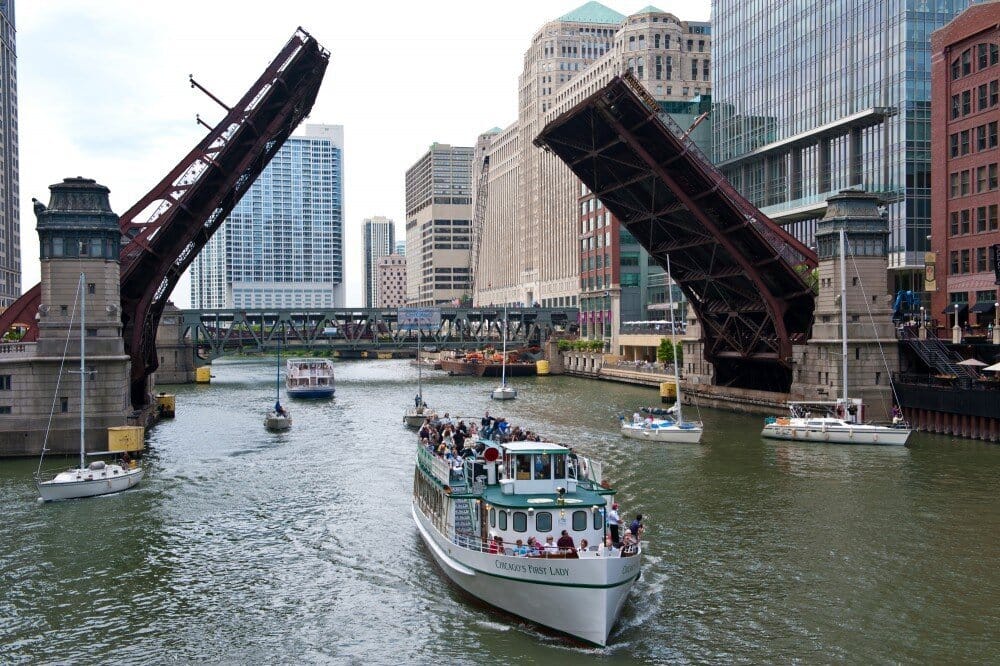

Chicago’s movable bridges
Chicago is not just home to many of the world’s earliest skyscrapers—it’s also a city of bridges. How and why did Chicago become home to so many movable bridges?
Chicago is not just home to many of the world’s earliest skyscrapers—it’s also a city of bridges. How and why did Chicago become home to so many movable bridges?
by Nikki Snodgrass and Jessica Cilella
Every day, Chicagoans head downtown, traveling to and from work, shopping, dining and generally navigating the area. The stunning architecture and skyscrapers give us plenty of reasons to look up, but next time you cross the river along Michigan Avenue, State Street, Wells Street or Wabash Avenue, look down. You’re walking on one of five different types of movable bridges found in Chicago. There’s a total of 37 movable bridges within the city limits.
EARLY BRIDGES
The earliest movable bridge in Chicago was a drawbridge at Dearborn Street built in 1834. Constructed of timber, it was similar to bridges found over moats at medieval castles, with large chains lifting it. In the years that followed, there was much trial and error as new styles were designed. A flood in 1849 swept away a number of floating bridges and drawbridges proved to be too narrow to accommodate the influx of people traveling through the rapidly growing city.
The first swing bridge completed in 1856 at Rush Street was an improvement, but the narrowness was still an issue. Swing bridges were set up like a spinner in a board game, which resulted in ships crashing into them, and vehicle collisions on them were common. In 1863, the Rush Street bridge actually collapsed under the weight of a herd of cattle being driven over it, further proving that the bridges were unstable and impractical. One of the few remaining swing bridges can be found east of Cicero Avenue across the Chicago Sanitary and Ship Canal.
A jackknife bridge was introduced in the early 1890s, but the style was not embraced by the city. Two other styles, the vertical lift bridge and the Scherzer rolling lift bridge, were developed in the mid-1890s. Both can still be found in the city. A vertical lift bridge is pulled up and down from counterweights in two tall towers on either side of it. The Scherzer rolling lift bridge is similar to a rocking chair, with large counterweights above the road level to help balance the bridge as it opens and closes.
Ultimately, though, it was the trunnion bascule bridge that became a Chicago staple.
CHICAGO STYLE BASCULE
The first trunnion bascule bridge in the country opened in 1902 over the north branch of the Chicago River at Cortland Street. Translated from French, “trunnion” means “pivot point” and “bascule” means “seesaw.” Also known as the “Chicago Style,” the bridge's leaves are suspended on axles (trunnions), with massive concrete counterweights located below the bridge, in the riverbank pit. There are single-leaf bascule bridges, which were constructed where the river was not very wide and often used for trains, and double-leaf bascule bridges, which could be compared to two seesaws across from each other.
What is it that made these bridges so unique to Chicago and so necessary to perfect? In 1830, right around the time of the first movable bridge design, the city’s population was about 4,000. By 1857, when the swing bridge was being introduced, the population had grown to 90,000. Bascule bridges were the most practical for these large and growing numbers of people and remain common today.
LASTING LEGACY
After 1910, involvement from the Chicago Plan Commission and architect Edward Bennett improved the bridges’ architectural elements, including bridge houses. These houses represent many major architectural styles, including Art Deco, Beaux-Arts and Modernism.
Some of the bridges that are still utilized in the downtown area are double decker, with vehicle traffic on the bottom level and L trains passing through on the upper level. Last year, two downtown bridges—at Jackson Boulevard and Lake Street—turned 100 years old!
At the beginning and end of each boating season, every downtown bridge is lifted, to allow people to bring their high-masted boats to the lake. This year, the bridge lifts will begin in mid-April. While it is quite a spectacle for some, many find it bothersome as they wait to walk or drive across the river. Those grumbling should take note, however, that the bridges used to lift much more frequently than they do today. In the 19th Century and part of the 20th Century, bridges were lifted or spinned on demand, whenever a boat needed to pass by. Today, they typically only lift on timed schedules.
